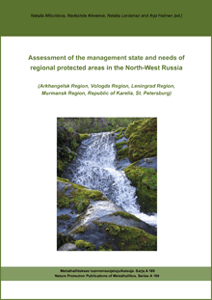Assessment of the management state and needs of regional protected areas in the North-West Russia (Arkhangelsk Region, Vologda Region, Leningrad Region, Murmansk Region, Republic of Karelia, St. Petersburg)
This report presents the results of the assessment of the management state and needs of regional protected areas (RPAs) in six regions in the North-West Russia: Arkhangelsk, Vologda, Leningrad and Murmansk Regions, Republic of Karelia, St. Petersburg. The assessment was carried out within the framework of the project “Development of regional PAs in the North-West Russia”. Some other project results are briefly presented.
The main aims of the assessment were to identify strengths and weaknesses of the RPAs management in the regions participating in the project and to determine its developmental priorities. Emphasis was made on revealing characteristic features and tendencies of management of the RPA network in each region. In addition, information on threats to RPAs was collected. The assessment was based on the Management Effectiveness Tracking Tool (METT) developed by the World Bank and WWF. It was performed by the staff of RPAs management authorities and experts from scientific institutions and environmental NGOs.
Background and methodology of the assessment are explained in Chapter 1. The main body of the report consists of six chapters devoted to the assessment results in the participating regions. Each chapter contains general information about the region, presents its PA network with the focus on RPAs and lists the threats to RPAs. A brief historical overview of the RPA network is given, and the authorities responsible for them are presented. The revealed strengths and weaknesses of RPA management are presented and discussed, and an identification of its developmental priorities is attempted. The conclusion contains a brief summary of the assessment results, some analysis of the general tendencies revealed and a few recommendations for future work. Appendices contain supplementary information on RPAs and on the assessment methodology.
The report is expected to serve as a tool for the RPA management authorities. In particular, the assessment results may be used as a basis for further monitoring of the RPA management effectiveness. The assessment methodology explained in the report may prove useful for other PA managing authorities in Russia. As a source of information about RPAs and their management in the six regions in the North-West Russia, the report will be interesting to a broad nature conservation audience. The report is published in English and in Russian.
